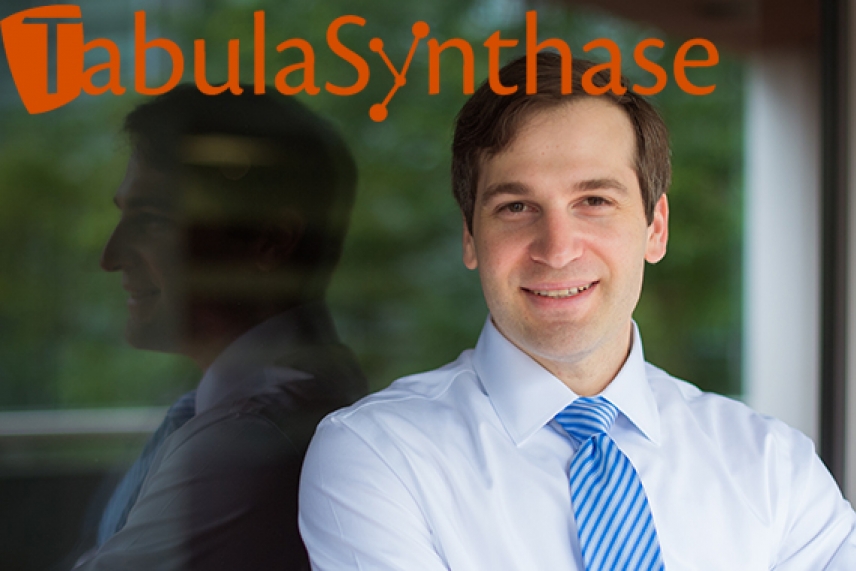
New Whitehead Fellow Kipp Weiskopf
TabulaSynthase, the blog of Whitehead Institute, brings together ideas and perspectives from the Whitehead community and beyond.
From high school through grad school, Kipp Weiskopf balanced a heavy academic focus and a healthy dose of competitive sports. He played lacrosse and football — where, as a middle linebacker, he had lots of head-crashing collisions.
“That’s led some of my friends to say, ‘Think what you could have accomplished by now if all your brain cells were intact’,” Weiskopf jokes. His friends were being ironic, because he is one of the nation’s emerging bioscience leaders: a physician and researcher who is helping drive the field of macrophage-based therapy for cancer — and an inventor with more than 10 patents and patent applications to his credit.
In October, Weiskopf brought his knowledge, skills, and innovative spirit to Whitehead Institute, where he is establishing his first independent research lab, as a Whitehead Fellow.
The appointment is a bit of a homecoming: Weiskopf’s first academic research experience came as an undergraduate working in the laboratory of then-Whitehead Fellow Fernando Camargo; it was also his introduction to the field of immunology.
Though not the first Whitehead Fellow to hold both an M.D. and a Ph.D. — his predecessors in that regard include Whitehead Member David Sabatini and current Fellow Kristin Knouse — Weiskopf is the first since George Daley, now the Dean of Harvard Medical School, to serve as both a Whitehead Institute lab leader and a practicing physician. Concurrent with his basic science research at Whitehead Institute, Weiskopf is completing a clinical fellowship in medical oncology at Dana-Farber Cancer Institute and sees patients in its Center for Immuno-Oncology.
“For many years, beyond helping me maintain good physical health, sports helped balance out all the mental and emotional energy going into academics and research,” Weiskopf reflects. That energy was considerable: he earned a B.A. in biology (summa cum laude with distinction) from Amherst College, during which time he also conducted research in the lab of Cold Spring Harbor president Bruce Stillman; next he headed to England’s University of Cambridge, where he earned an M.Phil. in biological sciences as a Winston Churchill Scholar (and won an award for his play with the Lacrosse Club); then he earned his MD and PhD at Stanford University, where he conducted research in the lab of world-renowned researcher Irving Weissman.
Weiskopf’s early research focused broadly on cell biology and the cell cycle. However, his medical school studies spurred a more focused interest in the interactions between cancer cells and the immune system. Cancer cells’ survival and out-of-control growth is substantially dependent on evading the body’s immune cells. In recent years, clinicians and researchers have become increasingly interested in interfering with cancer cells’ ability to block the immune system — and have looked for ways to leverage the body’s own immunological defenses to fight the disease. Most current immunotherapies focus on T cells, but Weiskopf has been pursuing the potential inherent in another target, myeloid immune cells such as macrophages.
During his doctoral research, Weiskopf characterized the interaction between the CD47 protein signal that appears on many cancer cells and the SIRPα receptor on myeloid immune cells; that interaction is a fundamental checkpoint in the process by which myeloid cells deal with cancer cells. Based on that interaction, he engineered methods for augmenting immune cell’s ability to kill cancer cells. That work demonstrated the potential for new CD47-based therapies for a range of cancers and applications, including lymphoma, breast cancer, small cell lung cancer and for CD47-based approaches that permit bone marrow transplantation without chemotherapy or radiation.
“In order to dodge the immune system, many cancer cells heavily decorate their outer surfaces with CD47,” Weiskopf explains. “When myeloid cells, including macrophages, encounter a CD47-covered cancer cell, SIRP⍺ receptors on the myeloid cells’ surface connect with the cancer cell’s CD47 signals and send a ‘don’t eat me’ message that tells the myeloid immune cells to stand down. This trick permits cancer cells to continue to grow and divide.” He has since co-founded a company to develop therapies that block the CD47/ SIRP⍺ interaction, thereby enabling myeloid immune cells to attack the cancer. And his innovative treatments are now under investigation in phase I clinical trials in patients with hematologic and solid tumors.
Today, rather than pursuing competitive sports, Weiskopf finds joy and balance in tackling family life. His wife is a nurse practitioner in Dana-Farber’s pediatric bone marrow transplant program. “She’s an amazing person in her own right,” he says. “And she’s had lots of practice at helping to keep me balanced—we first met in sixth grade and started dating in high school.” These days, they both get energy from their two young daughters. “We love taking them to the beach or to play in the park. And I’ve discovered,” Weiskopf observes, “that the mental effort of developing new immune-based cancer therapies is wonderfully balanced by the thrill of figuring out how many rubber ducks can fit in a bathtub.”
Topics
Contact
Communications and Public Affairs
Phone: 617-452-4630
Email: newsroom@wi.mit.edu


